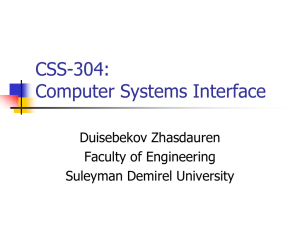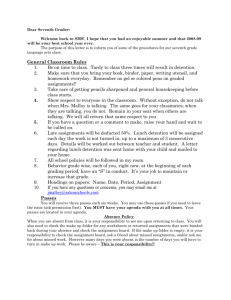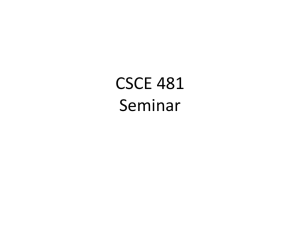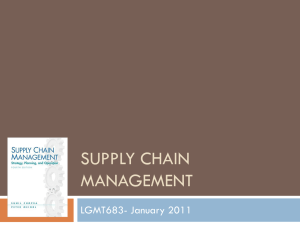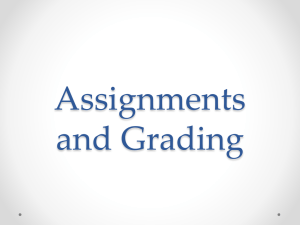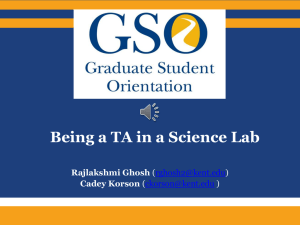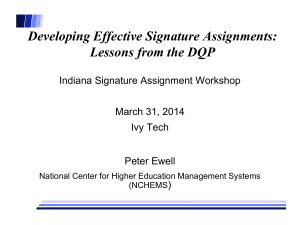Assessment - Chinhoyi University of Technology
advertisement
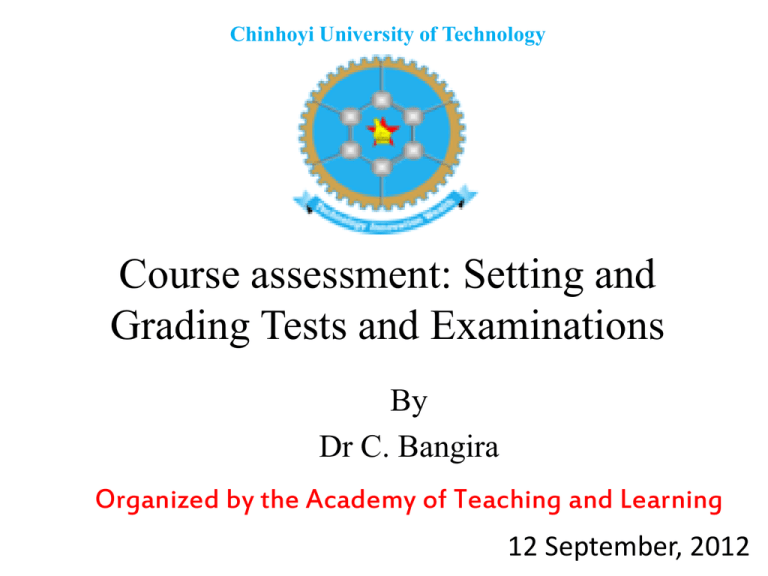
Chinhoyi University of Technology
Course assessment: Setting and
Grading Tests and Examinations
By
Dr C. Bangira
Organized by the Academy of Teaching and Learning
12 September, 2012
Introduction
• Academy of Teaching motto:
• Teaching excellence and improving student
learning
Lecturer
Student
• Teaching-learning process is usually assessed by,
tests, coursework assignments, practicals,
examinations, etc
Student’s performance and evaluation
• Assessment of student’s performance and
progress should be regulated by:
Objectivity
There should be agreement from various
stakeholders and observers on student
evaluation
Continuity
Avoid unnecessary changes to the whole
system of evaluation
Reliability
Marks should be based on many observations
of each student performance to increase
reliability
On average coursework should be based on at
least five (5) student performance observations
Validity
Tests should reflect the course content.
Validity can be increased by weighting of
various components of the final mark
Components of the final mark
Final Examination Mark
(100%)
Written endsemester
examination
(50-80%)
Continuous
assessment
mark (20-50%)
Tests, assignments and examinations
• The objectives of the tests, assignments
should be clear:
– Are individual students and the class
achieving course objectives?
– Design the tests and assignments to reveal
specific weaknesses and individual
achievements
Some Guidelines for Setting Tests and
Assignments
• Make a draft of the tests and assignments
based on the table of objectives and course
outline
– Include all topics
– Emphasize all important points and topics
– Make important points and topics compulsory
Develop a large pool of questions
– Develop questions on each course topic
– Select test questions from this pool
– Include some of the questions in the final or
semester-end examinations
Category of questions
• Theory
– e.g., ionic size: substitution of chemical elements in
structures
– Reduction/Oxidation: industrial extraction of Fe
from Fe oxides
• Mastery/Factual
– e.g., wavelength of the visible range….0.4-0.7 nm
– green pigment in plant leaves…….chlorophyll
– vowels ------ {a, e, i, o, u}
• Applications/Practical
– Integrate various topics in the course content
or subjects to solve a problem
e.g., Starting a business venture
»Cost-benefit analysis
• Economics
• Mathematics
• Computing and Communication Skills
• Accounting
• MOB
Nature of test questions
• Multiple choice
– Choose the correct answer (A, B, C, D, E)
• Essay
Discuss the impact of fast-track land resettlement
programme on the economy in Zimbabwe.
• Structured
– The sky appears blue because………..
Critically review tests and assignments
questions
• Check with original course outline and content
• Is the amount of emphasis on various topics
captured?
• Discuss tests/assignments with fellow lecturers
of the same subject
Time
• Due dates for assignments depend on the subject or
course
– Ample time (e.g., 2 weeks) should be given to students to
complete the assignments
• Classroom tests
– Should test student’s understanding of the subject rather
than speed of completing the test
– If >10 to 15% of students fail to finish the test in allotted
time, speed is probably a factor for some students
• Allow specific time for each question
– e.g., 30 minutes for each question
– Tests which are too long for the time allowed should be
avoided
Level of difficulty
• Level of difficulty of questions should be
appropriate to that particular group,
e.g.,
– (Post) Graduate vs undergraduate students
• Arrange questions in ascending order of
difficulty (to boost morale of the candidates)
– Easiest questions should be at the beginning of
section
– Most difficult questions should be placed in the last
sections
Similarity of test questions
• Test questions of a similar type should be
placed together,
e.g., Question 1.
(a) (i) Definition of terms
(ii) Calculations
(b) Applications
Figures, Tables and Equations
• All Figures and Tables referred to in the test questions
should have a title.
– Table Q1. Distribution of major universities in Zimbabwe
Figure Q5. Concentration of Cu in mine spoil selectively
extracted by different chemical reagents
Equations
• All equations should be numbered
a + bx2 + c = 0 ………………..(1)
r2 = x2 + y2……………………..(2)
What to avoid
• Monotonous sentence, e.g.,
– Explain the difference between…
– Explain what is meant by….
– Explain how……,
• Ambiguous sentences
– Which is the coldest month in a year?
What to avoid…..
• Use of
• Always
• Never
• Entirely
• Absolutely
• Double negatives, e.g., not uncommon,
Instructions to candidates
• Instructions to candidates should be concise
• Instructions should include, among other things,
–
–
–
–
Course name and course code
Time allowed
How and where to mark items
Whether calculations should be shown on answer
sheets
– What additional information/material will be provided
– Marks or points awarded to each correct answer
– Penalties, deductions for errors in spelling, grammar,
etc
Grading
• Grading is used to show the level of
performance of a student in achievement
tests
• Prepare answer keys and scoring procedures
before grading can be done
• Each correct answer can be awarded 0.5, 1,
2, etc, points or marks
Grading criteria
• Universities in Zimbabwe have adopted
Criterion-referenced grading system
-Student performance is compared to predetermined standards
e.g.,
Grade
Mark (%)
1
>75
2.1
75-70
2.2
69-60
3
50-59
Student performance
• Evaluate student performance by preparing
score charts
• Which questions were:
– performed very well
– badly performed
– average
• Revise and emphasize problem areas
Summary
• Assessment of teaching and learning is usually
conducted through assignments, tests and
examinations
• Tests and assignments should reflect objectives
and content of the course
• Grading is used to show the level of performance
of a student in achievement tests
• Design the tests and assignments to reveal
specific weaknesses and individual achievements
THANK YOU
